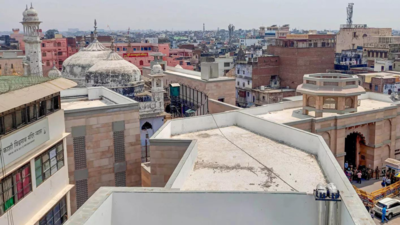Top Searches
- News
- India News
- 1991 Act won't apply to Gyanvapi case if 'Shivling' existed on Aug 15, 1947: VHP
1991 Act won't apply to Gyanvapi case if 'Shivling' existed on Aug 15, 1947: VHP

LUCKNOW: The Vishwa Hindu Parishad (VHP) has asserted that the Places of Worship Act 1991 will not apply to the Kashi Vishwanath Temple-Gyanvapi case if it is proved that the 'shivling' found inside the 'wuzu' (ablution) pond existed even on August 15, 1947.
"The presence of a `shivling' inside the complex points to the fact that it was a temple, and not a mosque, even in 1947. It’s a fair assumption that the shivling came up under Mughal occupation. Therefore, the Places of Worship act 1991 would not apply in the case of Gyanvapi-KVT complex," said VHP working president Alok Kumar, in an exclusive interview with TOI on Thursday. "The matter is in the court. Let us hope the truth will come out soon," he added.
The 1991 Act prohibits conversion of religious places and maintains their "religious character" as it existed on August 15, 1947.
The VHP stand comes a day after the KVT Trust chairman Prof Nagendra Pandey demanded that the shivling should be handed over to the Kashi Vishwanath Temple for proper worship till the matter is in court. On May 16, Kumar, too, had pointed out that the shivling, which was found in the presence of both the parties during the survey, categorically suggests that the area was a temple, which needed to be secured.
The Anjuman Intejamia Masajid, which manages Gyanvapi affairs and is one of the parties in the case, has maintained that the structure which plaintiffs and their lawyers are claiming to be shivling is actually a part of a fountain.
Experts said that the emergence of what is being called a shivling has potentially armed the right wing organisations to look beyond the regular worship of `Shringar Gauri' situated on the outer wall of the west side of the Gyanvapi complex. The deity was closed for regular worship -- except on the fourth day of Chaitra Navratri -- as a precautionary measure after the 1992 Babri Masjid demolition incident. Kumar said that Shringar Gauri was worshipped on August 15, 1947 and hence an unhindered access to deity should be allowed.
Some argue that the ‘Shringar Gauri’ shrine falls under the ambit of the Ancient Monuments and Archaeological Sites and Remains Act, 1958 and is, therefore, exempted from the Places of Worship Act as per Section 4(3)(1) and there is no violation.
The VHP sources said that the organisation has also taken strong exception to the statement of Rajasthan CM Ashok Gehlot calling Gyanvapi issue a "tamasha''. SP chief Akhilesh Yadav, too, had flayed the right-winger groups, accusing them of orchestrating religious disputes.
VHP national spokesperson Bansal said that such statements were highly condemnable and the Hindu Samaj would teach such politicians a lesson in the coming days. "These politicians are finding the mosque ancient but not the shivling. That shows their colors and the extent to which they can go for community appeasement," he said.
"The presence of a `shivling' inside the complex points to the fact that it was a temple, and not a mosque, even in 1947. It’s a fair assumption that the shivling came up under Mughal occupation. Therefore, the Places of Worship act 1991 would not apply in the case of Gyanvapi-KVT complex," said VHP working president Alok Kumar, in an exclusive interview with TOI on Thursday. "The matter is in the court. Let us hope the truth will come out soon," he added.
The 1991 Act prohibits conversion of religious places and maintains their "religious character" as it existed on August 15, 1947.
The VHP stand comes a day after the KVT Trust chairman Prof Nagendra Pandey demanded that the shivling should be handed over to the Kashi Vishwanath Temple for proper worship till the matter is in court. On May 16, Kumar, too, had pointed out that the shivling, which was found in the presence of both the parties during the survey, categorically suggests that the area was a temple, which needed to be secured.
The Anjuman Intejamia Masajid, which manages Gyanvapi affairs and is one of the parties in the case, has maintained that the structure which plaintiffs and their lawyers are claiming to be shivling is actually a part of a fountain.
Experts said that the emergence of what is being called a shivling has potentially armed the right wing organisations to look beyond the regular worship of `Shringar Gauri' situated on the outer wall of the west side of the Gyanvapi complex. The deity was closed for regular worship -- except on the fourth day of Chaitra Navratri -- as a precautionary measure after the 1992 Babri Masjid demolition incident. Kumar said that Shringar Gauri was worshipped on August 15, 1947 and hence an unhindered access to deity should be allowed.
Some argue that the ‘Shringar Gauri’ shrine falls under the ambit of the Ancient Monuments and Archaeological Sites and Remains Act, 1958 and is, therefore, exempted from the Places of Worship Act as per Section 4(3)(1) and there is no violation.
The VHP sources said that the organisation has also taken strong exception to the statement of Rajasthan CM Ashok Gehlot calling Gyanvapi issue a "tamasha''. SP chief Akhilesh Yadav, too, had flayed the right-winger groups, accusing them of orchestrating religious disputes.
VHP national spokesperson Bansal said that such statements were highly condemnable and the Hindu Samaj would teach such politicians a lesson in the coming days. "These politicians are finding the mosque ancient but not the shivling. That shows their colors and the extent to which they can go for community appeasement," he said.
FOLLOW US ON SOCIAL MEDIA
FacebookTwitterInstagramKOO APPYOUTUBE
Looking for Something?

Start a Conversation
end of article

